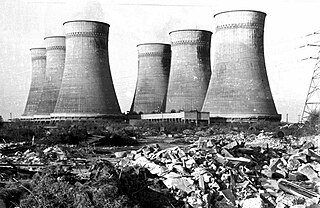
Rye House Power Station is a 715 MW combined cycle gas turbine (CCGT) power station close to Rye House railway station in Hoddesdon, Hertfordshire.

West Ham Power Station was a coal-fired power station on Bow Creek at Canning Town, in east London. It was often referred to informally as Canning Town Power Station.

Peterborough Power Station is a 360MW gas-fired power station at Eastern Industry, Fengate in the city of Peterborough, Cambridgeshire in the United Kingdom. It employs around forty people.

Little Barford Power Station is a gas-fired power station just north of the village of Little Barford in Bedfordshire, England. It lies just south of the A428 St Neots bypass and east of the Wyboston Leisure Park. The River Great Ouse runs alongside. It was formerly the site of two coal-fired power stations, now demolished. The station is operated by RWE.

Great Yarmouth Power Station is combined cycle gas turbine power station on South Denes Road in Great Yarmouth in Norfolk, England, with a maximum output of 420 MW electricity, opened in 2001. It is built on the site of an oil-fired power station, built in 1958 and closed and demolished in the 1990s. A coal-fired power station was built in Great Yarmouth in 1894 and operated until 1961. The station is operated by RWE.

Shoreham Power Station is a 420MWe combined cycle gas-fired power station in Southwick, West Sussex. It was built on the site of the Brighton B Power Station.

Staythorpe C Power Station is a 1,735 MWe gas-fired power station at Staythorpe between Southwell and Newark-on-Trent in Nottinghamshire, England, between the River Trent and Nottingham to Lincoln railway line. The station was handed over to the owner RWE from Alstom Power with full commercial operation being achieved in December 2010. The official opening ceremony attended by Charles Hendry, Minister of State took place on 9 May 2011.
Rotherham power station was a coal-fired power station sited close to the centre of Rotherham in South Yorkshire.
Stuart Street Power Station was a coal-fired power station in Bradford, Manchester, England.

Doncaster Power Station refers to two coal-fired electricity generating stations situated in the centre of Doncaster in South Yorkshire, England. Doncaster A provided electricity to the town from 1900 to 1958, and the B station from 1953 to 1983.

The Croydon power stations refers to a pair of demolished coal-fired power stations and to a gas-fired power station in the Purley Way area of Croydon, London.
Meaford Power Station was a coal-fired power station situated on the River Trent at Meaford near Stone in Staffordshire.
Watford Power Station was a coal-fired power station situated in Watford's Riverside area. The station was built by the Watford Corporation Electricity Department starting with the installation of cables in 1899 with completion around 1900, near the banks of the River Colne. A gas turbine power station was commissioned in 1980.
The Worcester Power Stations were a series of hydro-electric and coal-fired generating stations providing electricity to the City of Worcester.
Ribble Power Station was a coal-fired electricity generating station on the River Ribble in Penwortham near Preston, Lancashire, England. The station was built by the Corporation of Preston to replace a small privately-run generating station in the town. It supplied electricity to Preston and the surrounding area from 1923 until 1976. The station was expanded with new equipment in 1943–47 which remained in operation until the power station was closed in 1976 and was subsequently demolished.

Huncoat Power Station was located in Huncoat near Accrington, Lancashire. It was a 150 MW, coal-fired, electricity generating station in operation from 1952 to 1984. It has since been demolished. Huncoat power station replaced the earlier Accrington power station that had supplied electricity to the town since 1900.
Bromborough power stations are three electricity generating stations that supplied power to industrial and domestic users in Bromborough, Port Sunlight and the wider Wirral area from 1918 until 1998. Bromborough power station provided public electricity supplies from 1951 to 1980. Central power station Bromborough (1918–1998) was originally owned by Lever Brothers and supplied electricity to domestic users in Port Sunlight as well as electricity and steam to industrial users. Merseyside power station Bromborough (1958–1998) was also owned by Unilever and provided electricity and steam at a range of pressures to industrial users in the locality. All three power stations at Bromborough have been demolished.
Stourport power stations were two electricity generating stations that supplied electricity to Stourport-on-Severn Worcestershire and to the wider West Midlands area from 1927 to 1984. The two stations, A (1927–78) and B (1950–84), were collocated on a joint site adjacent to the River Severn south of Stourport-on-Severn.
The Thornhill power station generated and supplied electricity to the town of Dewsbury and the wider regional area from 1902 to 1982, and again from 1998. The first generating station on the site was owned and operated by the Yorkshire Electric Power Company. Following nationalisation of the British electricity supply industry in 1948 Thornhill power station was operated by a succession of state owned bodies. The power station was redeveloped with new plant in 1915, 1925, 1932–37 and 1950–54. The coal-fired steam station was decommissioned in 1982, and was subsequently demolished. A gas turbine power station on the site was commissioned in 1998.
Wolverhampton power station, also known as Commercial Road power station, supplied electricity to the Borough of Wolverhampton, England and the surrounding area from 1895 to 1976. It was redeveloped in several stages to meet growing demand for electricity: including the addition of new plant in 1902 to 1908, 1925 and 1942. The power station was initially owned and operated by Wolverhampton Corporation, but was transferred to the West Midlands Joint Electricity Authority in 1928. The British Electricity Authority assumed ownership at nationalisation in 1948. Wolverhampton power station was decommissioned in 1976.











